ALOHA CLASSIC 2019 | SURVIVE AND RIDE
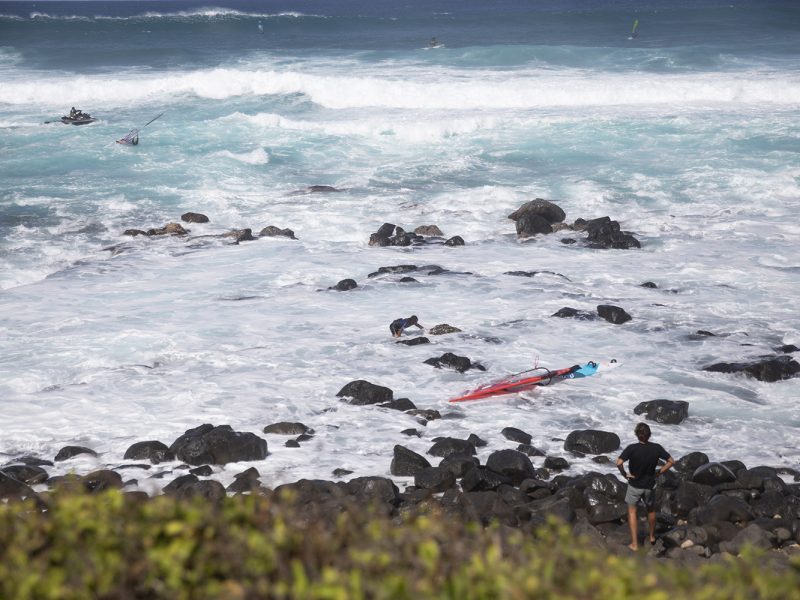
With no major PWA events taking place so far in 2020 we take a look back at the tough conditions the riders faced at the 2019 Aloha Classic which was featured in our March 2020 Issue: The 2019 Aloha Classic will go down in history as one of the most extreme float and ride if not survive and ride contests in PWA history. With world titles on the line and plenty of gear destroyed on Ho’okipa’s infamous rocks, the sailors did not hold back. We take a sideways look at the event as Graham Ezzy sets the scene with his take on the proceedings, while JC talks to some of the men and women who ventured into the swell to find out what equipment, technique and tactics they used to navigate a treacherous lineup.
Words: Antoine Martin, Graham Ezzy, Sarah-Quita Offringa, Morgan Noireaux, Leon Jamaer, Klass Voget, Kai Lenny, Ricardo Campello. // Photos John Carter
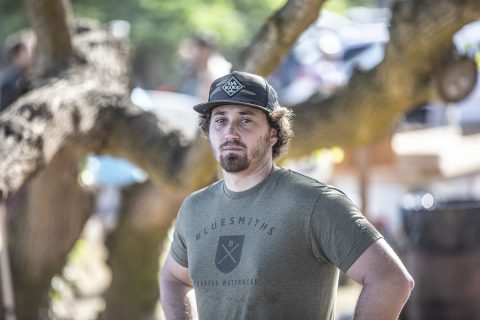
Graham Ezzy
“ IT minus 24 hours to the start of the Aloha Classic, and I got a call from Rich Page, the manager of the PWA World Tour. He said, “We have a problem. A big problem. We can’t start the event.” By this time, all the riders had already flown into the island from all over the world—and the judges too. Mercedes had written a check to secure title sponsorship. The world was ready for the start of the most watched windsurfing event in the world. A local law had just changed, requiring all events to hire security guards from a firm with a special license—only 2 such firms exist on Maui, and both were fully booked. The event’s permit requires onsite security, so no security meant no event. Page called me back to say that a loophole had been found: hiring off-duty police officers. But where could we find off-duty police officers for tomorrow morning? Off-duty cops were eventually found and the event was officially announced to start at 11 o’clock the following morning. But this hiccup was only one in a series of issues.
An election shook up the local Maui politics and removed many of the pro-business, pro-tourism incumbents who had previously supported the Aloha Classic. Maui’s tourism had exceeded all targets, and the locals unhappily felt that the island was catering to visitors at the expense of locals. The new Maui council was wary about the Aloha Classic—a bunch of foreigners invading the beach for over a week. Ho’okipa is the best wave sailing in the world. Sure, other spots have cleaner waves or longer waves. But Ho’okipa is a jack of all trades, and she is darn consistent. Despite the 12 hour time difference that means the livestream broadcasts in Europe in the middle of the night, the Aloha Classic has more European viewers than any other event.
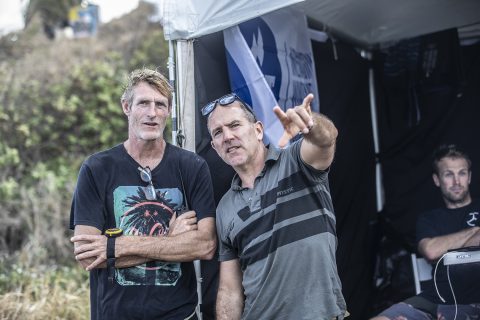
Forecast
Richard Page, Dawn Pooley, and Riho Shiraishi worked with the county on a back and forth conversation showing that the Aloha Classic is an opportunity for Hawaii’s windsurfers to shine on the world stage. Simeon Glasson, the owner of IWT, was in and out of the county offices. The permits were issued contingent on the guidance of a cultural advisor to ensure a respectful representation of Hawaiian culture. On the eve of the event, the forecast was confusing. The weather models did not agree. A swell was coming, that was for sure. But when would it arrive? Would it be too big? Would the wind disappear? These were the questions on our lips. We humans try our best to predict the chaos that is the weather, but at the end of the day, forecasts are just educated guesses, not schedules. Windguru predicted massive waves for day 1. For whatever reason, the Windguru models often get the swell wrong for Maui, too small or too big or too early or too late. For my own marine divinations, I use the human written forecasts on the University of Hawaii (UH) Meteorology website. The UH forecast said the swell would not peak until day 3. This lead to conflicting conversations. Some people were worried that day 1 would be too big to compete, with long lines of waves stretching from the left of the horizon to the right and breaking in one fell closeout. And other people (myself included) worried that there would not be enough swell.
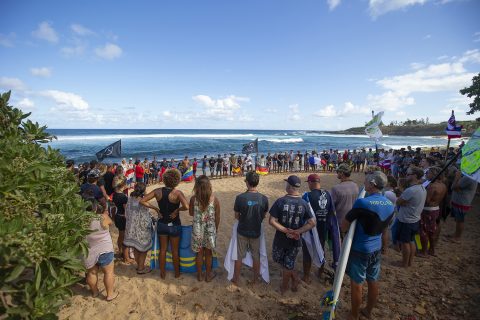
Blessing
The truth surprised everyone. On the morning of day 1, the ocean was flat. The swell was a rumour. The opening ceremony on the beach included, as in every other year, a native Hawaiian blessing. The ritual was lead by Kahu Kale Ka’alekahi. I’m generally apathetic in the face of ceremony, but I was moved and motivated. I later emailed him for a quote – “The competition in itself is beautiful because it gives us all a sense of purpose to come together and showcase our talents, these skills that we have been refining and cultivating from years of dedication. Everyone, all the competitors, the organizers, the contributors, come from different nations/countries, experiences and cultures, yet we find ourselves here on these islands in the middle of the ocean. This is what matters most: our ability to deeply connect to what gives us all life and continues to give us these gifts we call our talents and abilities, we receive all of this from the first and true giver, the living world! Remember where you come from, remember who you are, remember to remember, that the ocean and our world is how we have come to exist. We are because they have been, give yourself completely to this experience and to the enlivening of your whole self, this is where we call upon healing, this is where the blessing comes from, this is an evolution of our gratitude…” Towards the end of the ceremony, a helicopter flew overhead dropping a multitude of flower petals from the sky. As the flowers rained down, children from the local Pa’ia school chanted a native chant. Now empty of petals, the helicopter circled overhead as the photographers inside captured the moment from above.
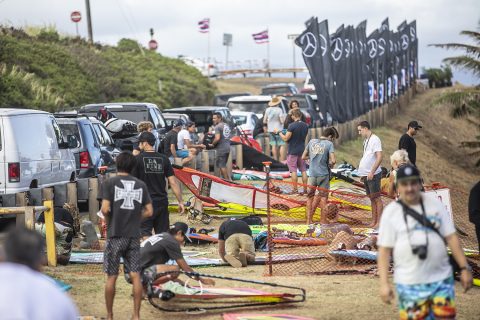
Game on
After the blessing, the contest was called on. The sets were about chest high and intermittent. The wind was light and anaemic. I pity the sailors who lost in the early heats. The waves began to show up, but slowly. Near the end of the day, some heats had nothing and others were epic and full of mast high rollers. Heats were decided on wave selection, a fundamental pillar of wave riding skill. In my heat that day, I only caught two waves, neither of them very big, but I knew that I had to make the waves count because I would not have another opportunity, so I milked every section I could find and somehow came in to the beach winning the heat. Day 1 ended with Sarah-Quita Offringa winning the single elimination, paving the way to her first wave world title, extinguishing any doubts to her dominance in women’s windsurfing. On day 2 the set waves were big, aggressive, and angry; the sets were inconsistent, yet we managed to complete the single elimination in fair conditions. The following are my highlights:
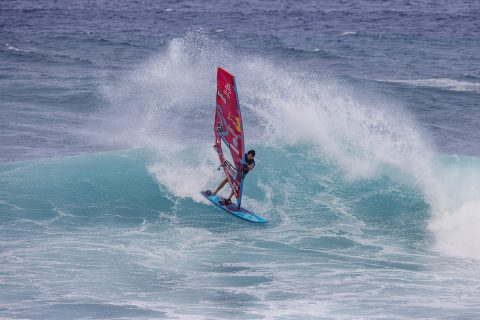
Koster comes 9th
Philip Koster, the wunderkind of the 20-teens, had already won 4 world titles going into the Aloha Classic, but yet, he had never passed a single heat at Ho’okipa. To Koster, the Aloha Classic was his kryptonite. But Koster is not actually bad at Ho’okipa or starboard tack sailing. The talented German can throw down his own share of moves and does not seem to be scared of big waves. I think the issue is the crowds. Growing up in the only house on Vargas Beach, Koster is used to sailing alone. Ho’okipa is an overcrowded fishbowl. The waves are almost always crowded with twenty or more of the best wave-catchers on the planet. To catch a wave is a battle of wills. Even though Koster spends time on Maui every year, he prefers to sail empty waves instead of fighting at Ho’okipa. But Ho’okipa is a beast of its own, and the only place to get good at Ho’okipa is Ho’okipa. Koster stepped it up this year and put in more time at Ho’okipa in the spring. His dedication showed. The heats were difficult, the waves were not only big but unpredictably spaced. This might make it sound easier to sail, but it made the heats very chaotic. You did not know whether the wave you were on would be your last. For example, in my last heat, I only rode one wave. I caught a second wave, but it was so bumpy and full of cross current that I didn’t do anything on it. And then the heat was over, and I lost despite having the highest wave score of the heat. C’est le Aloha. Koster really impressed me. He did what needed to be done and not only passed his first heat ever at Ho’okipa, but also made his first top 10 result there, securing his 5th world title.
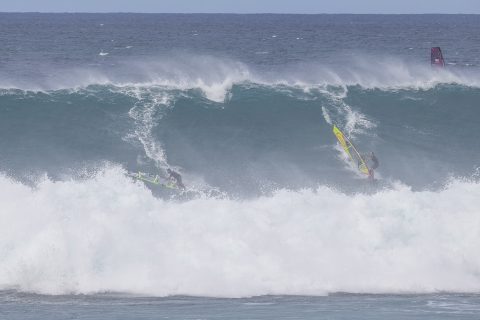
Campello vs. Schettewi
With the world title on the line, Venezuelan Ricardo Campello faced off against American first-year college student Jake Schettewi in the quarter finals. After the heat, Campello ran across the sand shouting at Jake: “You stole my wave!” Campello stormed off to the judges to protest the wave priority. As a PWA board member, I followed the commotion to see if I could be of any help. I grabbed Ricardo’s shoulder and told him to be calm. Ricardo said that Jake tacked on his wave. Jake said that he was on the wave first. This happens sometimes. PWA rules give priority to whoever first crosses over the crest of the wave before the wave in question. The judges reviewed the livestream footage which seemed to show that Campello passed over the preceding wave first and therefore did in fact have priority. Was Schettewi playing mindgames when he stole the wave from Campello? I do not think so. In the adrenaline pumped chaos of a heat, perceptions are far from perfect.”
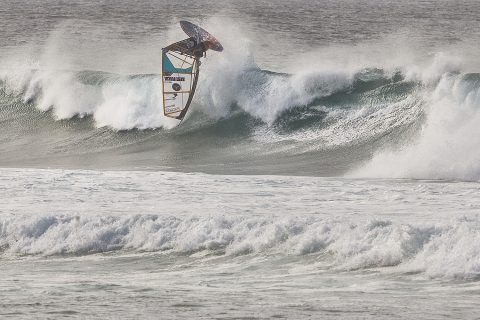
Roediger’s perfect 10
Graham Ezzy – “Wave riding is a little like the ‘Force’ from Star Wars—you either have an affinity for it or you don’t. And whatever ‘Force’ exists inside you, you still need to bring courage to the table. The kind of wave riding that gets you on the podium at the Aloha Classic, so says the talk on the guardrail, is something innate. You have to have courage and a spiritual connection to the waves. Mostly this is bullshit, but whatever is true about this philosophy exists inside Bernd Roediger. The morning of day 1, he sat on the guard rail strumming an acoustic guitar. He had not been sailing at Ho’okipa much the last year, but what Jedi master needs practice? What did Yoga say? “Try not… Do or do not. There is no try.”
Roediger has won the Aloha Classic before, twice in fact. And he attacks waves with a style that would be called playful if he were not so bold, dancing in the pitching lips of monster sized Pacific crushers.
Roediger earned the truest perfect 10 of the Aloha Classic. The wave was not particularly impressive in terms of height, but it was big and smooth and throwing forward fast as it hit the reef. Roediger timed the first hits perfectly and raced toward a section coming at him, a good air section but definitely too gnarly to attempt any kind of trick. If he had just hit the section and done a straight air in front of the wave, this wave would probably have scored an 8. Instead, he threw himself head over heels and rotated a goiter off of a section that was 100% not a goiter section. Yet, he landed softly and perfectly rotated. The beach erupted in applause. The Jedi bowed. Every Jedi needs an empire to fight against, and for Roediger, that seems to be the PWA and organized windsurfing. On the chest of the event lycra was the Mercedes logo, on the right shoulder was the PWA logo and on the left shoulder was the IWT logo. At one point in the event, Roediger ripped off the right sleeve at the seam, removing the PWA logo from his lycra. Rich Page, the PWA tour manager, politely told him, “Oh, your lycra seems to be defective. Here is a new one.” The Hawaiian ripper, despite his obvious talent, never ventured onto the world tour. I don’t blame him. The onshore, port tack jumping events of the world tour are a hard place for a Hawaiian. Roediger placed 3rd in the event.
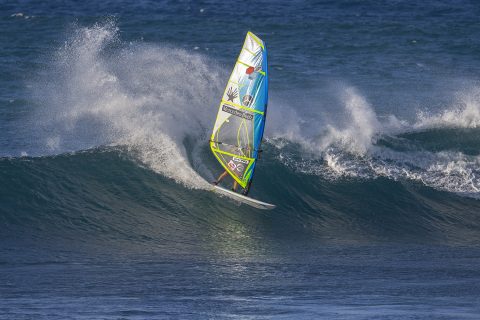
My journey
The year before, I placed 3rd in the Aloha Classic, and I was hungry to do better this year, eyeing the first place trophy. My body felt good, and my equipment worked perfectly, I was the most confident I’ve ever been going into an event. But the ocean simply was not there for me. My heats were mostly waveless. I finished 9th, but to my surprise, I have no unhappiness at all. Fate, simply, did not blow my way. C’est le Aloha.
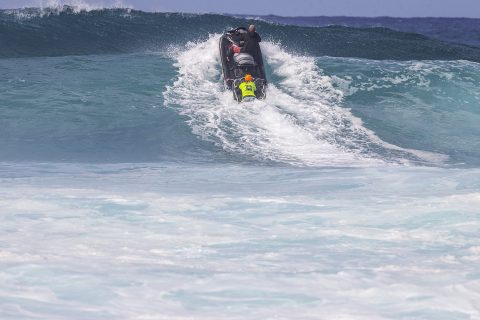
Real heroes ride jet skis
The real heroes of the event were the water safety—Jay Sniffen and Marc Pokini. The judges wanted to limit the rescues in each heat to avoid any unfair advantages. But the waves were so big and powerful that the rescue team refused to step down. Sniffen and Pokini pulled into the rocks to save riders and their gear in a display of sportsmanship and courage rivalling anything that we were doing on the waves.
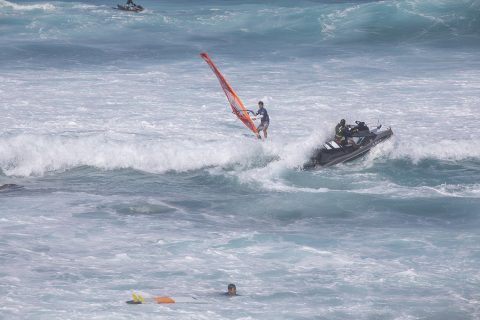
Day 3 and 4
The ocean was such a chaos on day 3 that the heats were repeatedly cancelled due to incontestable seas. A flow of riders exited from the rocks. Diony Guadagnino and Boujmaa Guillol sailed and resailed their heat until they simply refused to compete. They said that the conditions were too intense and that competing was an unnecessary risk to life and limb, and equipment. The day was called off. Day 4 only saw less than 3 hours of wind, just enough to finish the youths. Some pros were grumpy that day 4 was not used to further the double elimination, but with no wind on day 5, those heats would have been pointless. I, personally, am happy that the future of our sport had a chance to shine in the spotlight.”
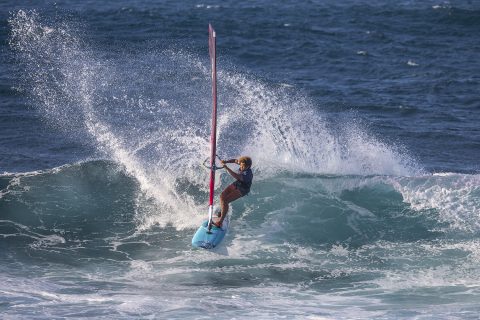
SARAH-QUITA OFFRINGA
The day the women sailed the single elimination the swell was not at its peak, even though we did see glimpses of what was to come. Every other heat this massive set would roll in. That definitely got my heart pumping. I’m still not a big fan of big surf, but that’s exactly where I want to improve, so I was ready for battle! I came into Ho’okipa as the tour leader, but I know how good everyone else is at Ho’okipa, so the main goal was just to do my best there. It was a tricky day because the wind was up and down a lot. So I had rigged from 4.5 to 5.0. But in the end I stuck to my 4.7. I couldn’t see it from land, but it was really hard out there. The wave face was very choppy, which made it really hard to initiate the bottom turn. I remember there were one or two waves I had to chop hop down before I could start the first turn. It did smooth out towards the end of the day though.
I’m super impatient normally, and because I still don’t surf that much my wave knowledge and selection might still not be the best. So I tried to sail at Ho’okipa as much as possible to get used to the spot. I went down to Lanes once during practice because it was so busy at Ho’okipa, and it was definitely worth it because I was catching wave after wave down there, but when I came back my timing was off for Ho’okipa. So I made sure to stay up there to train afterwards. Once I was competing I felt comfortable in the water and I knew what I was doing. I think it was to my advantage that we didn’t have the biggest waves, it allowed me to be totally comfortable and I charged to the best of my abilities. It was awesome to be out there with only four others. I sailed my 4.7 and 86 litre Starboard KP custom model all day with an 11 and 18 cm thruster setup. This is the only spot I use a custom board, and it makes a huge difference. The board is much calmer in the water and even on the choppy face I was able to draw out some good lines with it.
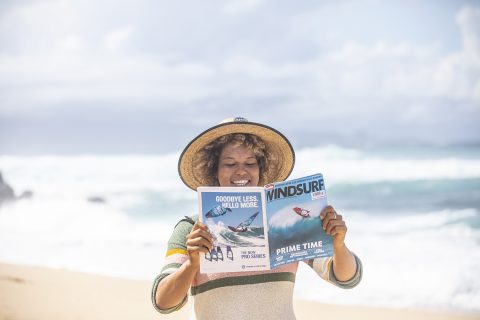
My 4.7 is a Neil Pryde Combat and I used it with my 100% carbon masts, that’s just how my sail works best. The wave is so powerful, you’re mast is going to break anyway if you’re in the wrong spot. At Ho’okipa I used 30 inch harness lines, whereas in the Canaries I’ll use 32 inch. I have my boom lower than I would use for freestyle, at about chin height, but I have definitely not followed the trend yet of the mega low boom. I feel so underpowered with my boom that low and am not comfortable on the board.
Only in the final with the dying winds did I decide to come back in and switch for my 5.0. In the end I was really able to use that extra power in the dying wind. For free sailing it’s okay if you’re underpowered or floating around, but in a 20 minute heat you gotta give yourself the best chances! It was a last minute decision so I came into the lineup really late, but I kept telling myself that I was exactly at the right spot. One or two waves did show up, which I rode into the end bowl and after that I floated as much upwind as I could and ignored the bumps coming my way as I wanted to wait for the best set. And that’s when it slowed down! I think I waited about 8 minutes for that last wave. It was nerve-racking. All that time I figured that Iballa was ahead, so I forced myself to wait for the bigger waves which I could score more on.
Finally that last set did come, and I just told myself go, go, goooo. I only remember that I had a good hit on the last section and that did turn out to be my best scoring wave. Yeah!! I sailed straight in from there. Hearing at the beach that I won was so cool. I was a bit surprised at first and then there was total elation. I’ve never beaten Iballa in float and ride conditions before and I was prepared to hear that she won it, so when it turned out to be me I was absolutely thrilled. Later on it settled in that the forecast wasn’t too good, which in my position was a good thing, but also made me realize that the title was won on that day, and that I could have easily lost it. So every heat matters. All the decisions you make matter. There isn’t always a second chance.
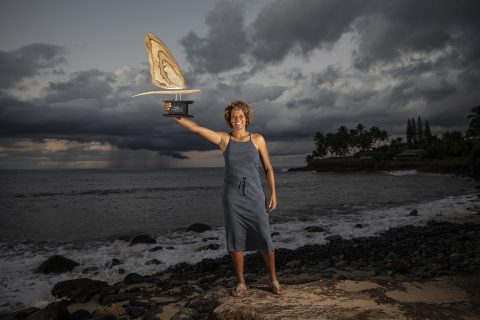
So winning the Aloha classic for the 2nd time really means a lot and with that also my first wave title feels amazing. It was a great year with a big variety in conditions and it’s just awesome to see the results of my efforts from the past years. It’s a weird feeling though, because I still feel like I’m the freestyler trying out waves, but it seems I’m doing something right. Even though I have the title now, I still feel this huge drive to get better at it. There are so many different conditions I still need to improve on. It’s not as technical as freestyle manoeuvres, but a wave is so unpredictable which means you always need to adapt to it, and that makes it really interesting. I still need to improve my starboard tack jumping, I want to get more comfortable in big waves, and it’s about time we kick down the door of double forwards and push the level forwards in competition. Let’s do this!!
“All the decisions you make matter.”
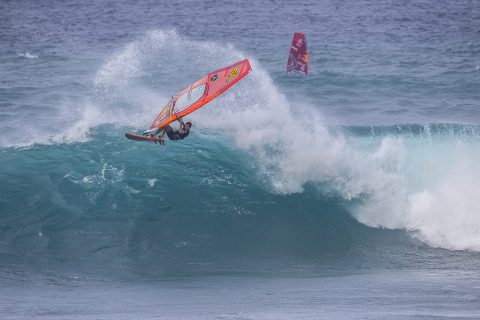
MORGAN NOIREAUX
I was actually pretty happy when I saw it was big. It’s nerve racking, but I’ve sailed in these type of conditions a lot; living a few minutes away from Ho’okipa has it’s perks. When it’s big and has a lot of west swell the current turns into the lineup making a lot of the waves really bumpy, but at the same time the end bowl section can get really hollow compared to normal days. The west swell also closes out the channel a lot which makes timing your sail around the rocks critical. It’s really easy to mistime it and break everything, which we saw a lot of! If you do make it around the rocks, the current does make it really easy to get out and upwind though. Even if there is a huge closeout set you can kind of sit on the inside after the rocks and wait for it to pass. A lot of it comes down to local knowledge. When it’s big, it’s easy to see who has spent a lot of time out there and who has not. The person who wins in these conditions has the best wave selection and is hitting the most critical sections and Antoine definitely did that best!
My favourite moment was my first heat. I got two of the nicest, cleanest waves I think I’ve ever ridden at Ho’okipa, which was pretty cool. In terms of gear I used my 3 batten 5.1 Fly and my 85 litre JP Ultimate Wave board. That’s the biggest gear I will use on Maui on any given day. I love 3 battens in side-off conditions, I find them noticeably better in these type of conditions as opposed to 4 or 5 batten sails. I’m always surprised no one else is using them. I had only just received my new boards, so I was actually using the same board as last year. It’s very similar to the production Ultimate Wave, just a bit more rocker and a tad shorter. They have a subtle winger which works amazing, particularly on bigger boards. I used my normal 100% carbon mast, it doesn’t really mater what kind of mast you use if your gear gets smashed on the rocks, so you might as well take the light one. I use a quad setup with 14.5 and 9 cm fins and my harness lines are size 30”. I think my boom height is pretty low compared to most people; I’m 6’1 and my boom is about 3/4 of the way down.
“A lot of it comes down to local knowledge.”
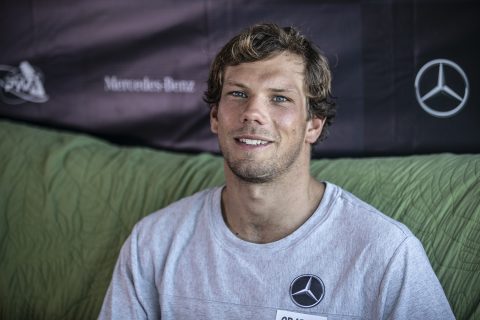
LEON JAMAER
On a big Ho’okipa day like this with light wind and few sets it’s a lot about confidence, experience and staying calm. I only brought one board to Maui, the production Ultimate Wave 88, so I didn’t have to worry about board choices. I feel really confident on that board as I can sail it in super light winds, get planing early and at the same time it rides radical enough to do all the turns and tricks. I use that same board everywhere around Europe. In Ho’okipa however I equip it with different quad fins, which have more rake and provide better control. My sail choice was either 5.0 or 5.3 Combat in HD version to make sure the rig would last a heavy beating. These four batten sails bring powerful drive and smooth comfort at the same time, which is perfect for wave riding. I used both the super strong 90% and the slightly lighter 100% percent carbon masts and both worked great. I have the boom at a standard medium height – neither high nor low – and my harness line length is 30”.
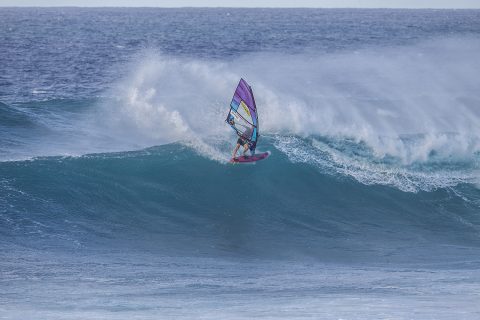
Most people left the beach about 15 minutes early for their heats. The heat duration was 22 minutes, which is quite short given the few rideable waves coming through. I knew it would be important to wait for a good one and not waste any time on waves that wouldn’t give a score anyway. This tactic proved to work well as I managed to advance over some absolute Ho’okipa rippers who didn’t pick the good waves, but it also meant that I sometimes had to wait for a second score in the last minute of the heat. My best moment was sailing the semi-final quite stacked on 5.3 with plenty of sets coming in. I had a wave with a big clean wall which allowed me to do one of the best turns I ever did in Ho’okipa, even though I was on the edge of control. I knew I was on my way to a good score, saw a big air section down the line, went full speed and then mistimed it by a split second just to get eaten by the wave – my hopes for the final shattered. After that crash I changed down to 5.0 which cost me a lot of time, however, I managed to find a good wave just before the end which was enough to give me 5th place overall for the event.
“It’s a lot about confidence.”
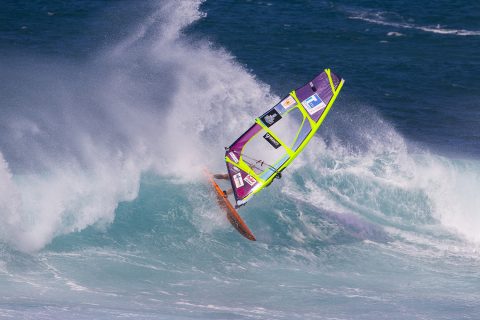
RICARDO CAMPELLO
To be honest I was one of the only sailors holding back! I am normally the one going the most to the rocks during free sailing and taking risks during the competition. This year at the Aloha I made the big mistake of playing safe and not going for it. I actually did not break any equipment this year and that is something really rare for me on Maui! The conditions were a big gamble, I didn’t sail to my ability at all, like I said I didn’t risk it and picked the wrong waves, it was hard to read the waves because every set was different! There were some huge sets and if you were at the wrong place at the wrong time that was it for your heat, that is why I tried to play it safe. Wrong call as it turned out! I wanted to use my ‘magical’ 82 litre board that had its tail broken on the plane in whilst in transit to the Red Bull Storm Chase last winter. Timo Mullen helped shape the tail again for me; it is a sick board and I feel I can really rip in Maui on it. The wind was far too light for it, so I had to pick my new 92 litre. I did not have time to get used to it before the event as I had just received it and to be honest trying something new on a big day at Ho’okipa was not ideal. The swell was huge with a lot of west in the direction. Picking the right waves was the key, but it was not an easy task! The bigger ones were mostly closing out, bumpy and sometimes with less wind than normal!
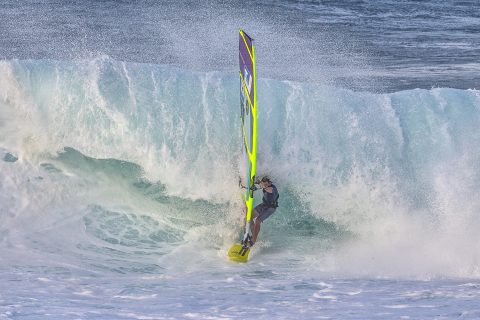
I was on my biggest board and sail during the event except my first heat, then I used my 92 and 5.0, but for the last heats I had to rig my 5.3, which I don’t like using in those conditions. You had to float and get going as soon as you could so as to not get stuck on the inside! I would normally go out half a heat before to make sure I had time to be out and in position for my heat and be a bit upwind! For my last heat, I headed out and towards the channel and there was a massive set, about seven waves all closing out. I had the option to chicken tack and then get stuck on the inside again where there was no wind or face the wave and try to make it out! Brawzinho was in his heat and got stuck on the inside getting about six waves on the head and nearly went to the rocks. I was lucky enough and made it out somehow, do not ask me how! The whitewater was like mast high and I made it through seven or eight waves, that was pretty much the only time I had “balls” during the event!
Obviously my Maui board is more of banana shape then the boards I use in other places because Maui is all about riding! I think it is about 58 cm wide and very floaty! All my boards are quad setups! I use MFC’s 250 quad set for fins. I use regular masts and luckily did not break any. I always use 34 inch harness lines! As for boom height I just go by my eyes!
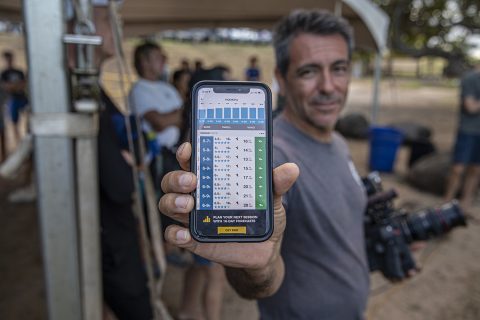
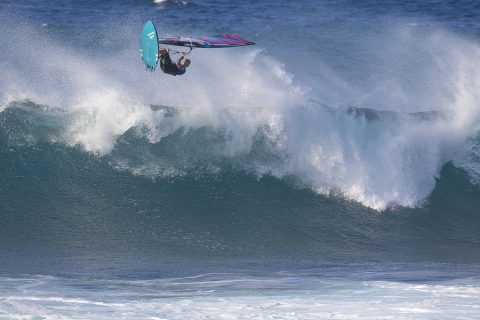
KLAAS VOGET
Usually I keep an eye on the sets at Ho’okipa and when a big one comes in, mostly there is a little bit of a quiet moment before the next set comes. So I jump onto my board when the set is breaking, by the time I’m close to the rocks the last whitewater is passing and there is time to float out into the channel. Once in the channel you’re pretty much safe, unless you float too far downwind and get taken out by a big Lanes bomb, or you get closed out by a massive set that connects between Ho’okipa and Lanes. If one of those comes, you either commit and try to make it over, or you chicken tack a few times on the inside until the path is clear. Either way, from the channel you usually make it out at some point. Once in the lineup, it can be tricky to find the good ones when it’s big. The first ones are usually bumpy, as the channel can create a lot of chop on the wave face from all the current. The second one can be good, but as it’s mostly bigger, it can still be choppy. By the third wave of the set, the surface is usually more clean. Ideally the third wave is of equal size as the second, as then you can have a nice clean face to ride. If it’s slightly smaller, you better get out, as it can turn into a foamy one. Same goes for the 4th or even 5th wave of the set. The longer the period of the swell, the more waves you could see per set. When it’s big, I usually never get into the first two waves of the set if I have the choice. That also makes your chances bigger to get back out after your ride, as there is not 2-3 massive walls behind the one you’re riding!
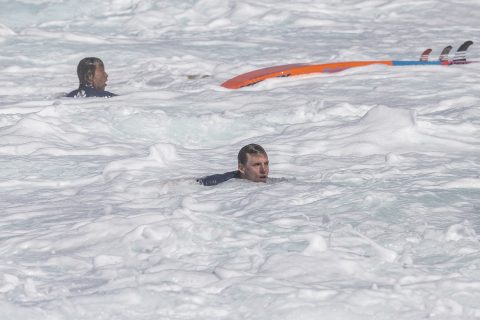
For large swell and light winds, I tend to use boards with flotation and sails which don’t exceed 5.0, even 4.7 if at all possible. I’m 72 kg and I use 84 litre boards; you need volume to make it out. When picked up by a 5 metre plus wave at Ho’okipa you accelerate up to solid speeds quickly. From floating around before, you can be even overpowered on the wave, especially if the wind is slightly offshore and the wind is pushing up the face. If the wind is a bit more onshore, you need more sail to get around the sections though. I’m always using quad fins for grip and drive when sailing in down-the-line conditions. I’m on 4 batten sails with 33” harness lines and the regular Duotone platinum mast. It’s 100% carbon, but they are quite strong anyways. When it’s big I have the boom slightly higher I think, as that frees up the board a bit.
“You need volume to make it out.”
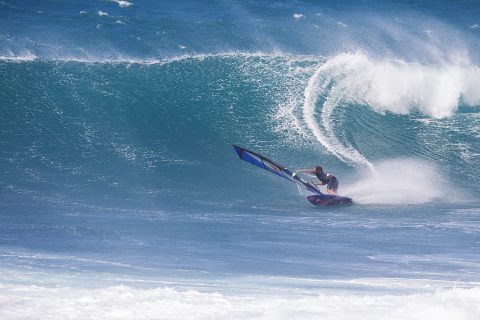
KAI LENNY
The Aloha Classic no doubt tested every sailor that went out. With light winds and big swell the rocks became an unsurprising and very likely place to end up. My own experience was getting washed into the minefield of rocks but being able to escape without a scratch except for on the deck of my board. A benefit of it being big is the amount of water on top of the rocks. Play your cards right and you can swim off, thought it takes quite a bit of experience and time spent on the rocks to know how to do it! That being said, if you’re out there to win you’ve got to be willing to trash everything. You could be the best sailor in the world, but when the wind dies and a close out set comes in there’s nothing you can do. The only thing that may help is reading the horizon and looking for that set!
I rode mainly a 5.0 and 4.7 Goya Banzai 4 batten with two backups of that. My board of choice was a 78 litre Quatro custom quad board. The board is and was so good I have had it repainted three times over the past 3 years. There’s some magic in that board that I’m not at liberty to disclose ha ha! My mast choice was a 90% Goya mast, not as light as the 100% carbon mast but stronger. My whole gear setup was still so light! My harness lines were 30” and my boom height was up to my chin.
“You’ve got to be willing to trash everything.”
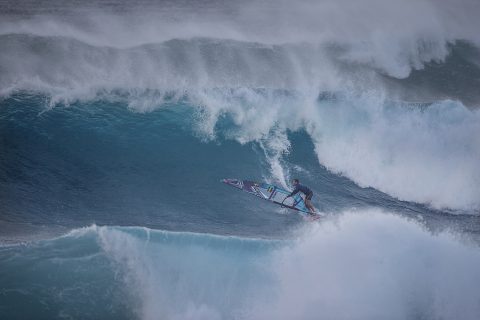
ANTOINE MARTIN
We knew there were only a few days of competition this year, so it was likely that we would not finish the double. That meant we only had one chance which was stressful. I was really anxious before the contest. I could not sleep at night and was super excited. I have done so many contests this year that the Aloha was just going through the motions again. Back in the day when I was only doing the PWA with just three or four events a year, by the time we had the Aloha there was too much pressure and I was losing my mind. This year with the IWT it was just another event for me. That helped me go through those heats.
The technique in big conditions is to be smart. It is great to be able to hit big lips and make big manoeuvres, but before you do those you usually need to make sure you have points. You have to pass the rocks and make it through the channel, which was gnarly. Then it was a matter of waiting for the best sets, which is a matter of knowledge built up over years of sailing at Ho’okipa; don’t pick up the west sets that close out. It was very technical with the light wind. It was very important to be calm and choose the right waves. My strategy was not to be too radical and try and pick the very best sections. It was a long held dream of mine to win this competition and now it has come true!
“Don’t pick up the west sets that close out.”
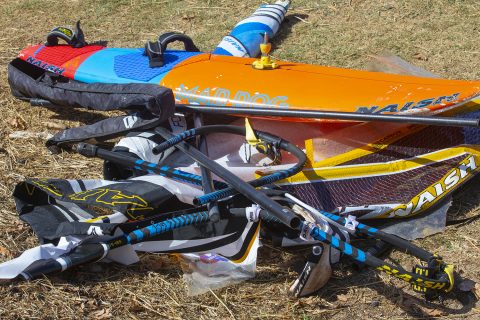
The post ALOHA CLASSIC 2019 | SURVIVE AND RIDE appeared first on Windsurf Magazine.
Windsurf Magazine https://ift.tt/37FTMO9